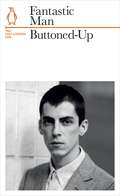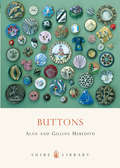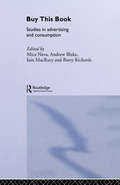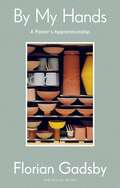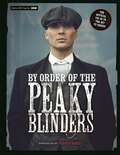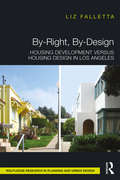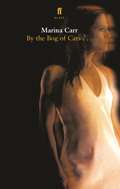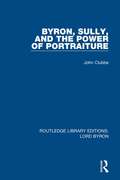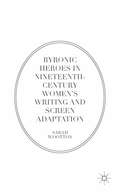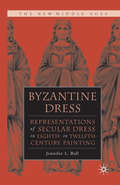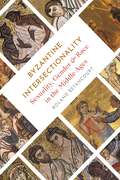- Table View
- List View
Buttoned Up: Clothing, Conformity, and White-Collar Masculinity
by Erynn Masi CasanovaWho is today’s white-collar man? The world of work has changed radically since The Man in the Gray Flannel Suit and other mid-twentieth-century investigations of corporate life and identity. Contemporary jobs are more precarious, casual Friday has become an institution, and telecommuting blurs the divide between workplace and home. Gender expectations have changed, too, with men’s bodies increasingly exposed in the media and scrutinized in everyday interactions. In Buttoned Up, based on interviews with dozens of men in three U.S. cities with distinct local dress cultures—New York, San Francisco, and Cincinnati—Erynn Masi de Casanova asks what it means to wear the white collar now. Despite the expansion of men’s fashion and grooming practices, the decrease in formal dress codes, and the relaxing of traditional ideas about masculinity, white-collar men feel constrained in their choices about how to embody professionalism. They strategically embrace conformity in clothing as a way of maintaining their gender and class privilege. Across categories of race, sexual orientation and occupation, men talk about "blending in" and "looking the part" as they aim to keep their jobs or pursue better ones. These white-collar workers’ accounts show that greater freedom in work dress codes can, ironically, increase men’s anxiety about getting it wrong and discourage them from experimenting with their dress and appearance.
Buttoned-Up: The East London Line (Penguin Underground Lines)
by Gert Jonkers Jop Van BennekomLondon is a centre of cutting-edge fashion - in Buttoned-Up, the creators of 'the best fashion mag out there', Fantastic Man, tell the story of London style through the history of the button-down shirt - part of a series of twelve books tied to the twelve lines of the London Underground, as Tfl celebrates 150 years of the Tube with Penguin'Taking a seemingly singular point of focus, the top-button-buttoned shirt, [Buttoned-Up] is a sartorial romp along the Ginger Line, looking at the curious fashion phenomenon through the eyes of its greatest exponents, including the Pet Shop Boys' Neil Tennant, who is pictured like everyone else in the book, buttoned up to the top'-Design Week'Authors include the masterly John Lanchester, the children of Kids Company, comic John O'Farrell and social geographer Danny Dorling. Ranging from the polemical to the fantastical, the personal to the societal, they offer something for every taste. All experience the city as a cultural phenomenon and notice its nature and its people. Read individually they're delightful small reads, pulled together they offer a particular portrait of a global city' Evening Standard'Exquisitely diverse' The Times'Eclectic and broad-minded ... beautifully designed' Tom Cox, Observer'A fascinating collection with a wide range of styles and themes. The design qualities are excellent, as you might expect from Penguin with a consistent look and feel while allowing distinctive covers for each book. This is a very pleasing set of books' A Common Reader blog'The contrasts and transitions between books are as stirring as the books themselves ... A multidimensional literary jigsaw' Londonist'A series of short, sharp, city-based vignettes - some personal, some political and some pictorial ... each inimitable author finds that our city is complicated but ultimately connected, full of wit, and just the right amount of grit' Fabric Magazine'A collection of beautiful books' Grazia[Praise for Fantastic Man magazine]:'The best fashion mag out there ... Fashion-forward, clever, deeply engaged with the fashion world, ... Fantastic Man is better designed, better photographed and rafts more stylish than the competition. If you buy only one men's fashion magazine, it should be this one', San Francisco ChronicleGert Jonkers and Jop van Bennekom are the creators of Fantastic Man, a formal and intelligent men's fashion magazine that positions itself above the commercial fray with a singular tone and elegant design. In 2010 they launched the female counterpart of Fantastic Man called The Gentlewoman, a modern ladies style journal.
Buttons: A World Champion's Story (Shire Library)
by Alan Meredith Gillian MeredithButtons have been made from almost every known material. Their study provides insight into fashion trends, the clothing industry and social history in general. This book introduces an array of these treasures from the past, to show the variety of materials and the intricate design and workmanship incorporated in the making of the button.
Buy This Book: Studies in Advertising and Consumption
by Mica Nava Andrew Blake Iain MacRury Barry RichardsBuy This Book is an important contribution to the history and understanding of consumption and advertising. This book brings together an outstanding collection of writing on the study of advertising, consumer practices and the future directions of research. Advertising and Consumption constitutes an invaluable resource for researchers, teachers and students. The essays are based on new textual and ethnographic research and engage with existing theoretical and historical work to form a volume which is a challenging companion to studies in this field.
Buy This Book: Studies in Advertising and Consumption
by Mica Nava Andrew Blake Iain MacRury Barry RichardsBuy This Book is an important contribution to the history and understanding of consumption and advertising. This book brings together an outstanding collection of writing on the study of advertising, consumer practices and the future directions of research. Advertising and Consumption constitutes an invaluable resource for researchers, teachers and students. The essays are based on new textual and ethnographic research and engage with existing theoretical and historical work to form a volume which is a challenging companion to studies in this field.
Buying and Selling Multimedia Services
by Gerry SouterThis book is a comprehensive guide to buying and developing multimedia in the most cost-effective manner. Focusing on the human factors in producing multimedia, rather than just the software, Buying and Selling Multimedia Services is aimed at both buyers and sellers of multimedia services and draws on real-world anecdotes¦war stories¦from project diaries and first-hand experience, to provide examples of the key ideas delineated within the book. These are true stories culled from 25 years of working on both sides of the desk as a purchaser of creative services for a Fortune 500 company and as a producer and seller for one of the largest multimedia production shops in the country. This book helps the multimedia producer and buyer to recognize flaws in past performances and to anticipate situations in future projects in order to save money and eliminate boardroom confrontations. Accusations, altercations, and recriminations can be avoided and the bottom line enhanced with the production of an effective product targeted to a receptive audience. Souter examines the skills necessary to both the producer and the purchaser of multimedia, allowing each to see the others' problems and viewpoints. Viewing the multimedia project from both sides, as both buyer and seller, Souter highlights the issues which will allow for effective communication between parties, resulting in a better product and a more creative relationship among all involved. In the second part of the book, Souter provides a comprehensive guide to all the digital formats available, to help the buyer and the developer select the most appropriate for a given project.
Buying and Selling Multimedia Services
by Gerry SouterThis book is a comprehensive guide to buying and developing multimedia in the most cost-effective manner. Focusing on the human factors in producing multimedia, rather than just the software, Buying and Selling Multimedia Services is aimed at both buyers and sellers of multimedia services and draws on real-world anecdotes¦war stories¦from project diaries and first-hand experience, to provide examples of the key ideas delineated within the book. These are true stories culled from 25 years of working on both sides of the desk as a purchaser of creative services for a Fortune 500 company and as a producer and seller for one of the largest multimedia production shops in the country. This book helps the multimedia producer and buyer to recognize flaws in past performances and to anticipate situations in future projects in order to save money and eliminate boardroom confrontations. Accusations, altercations, and recriminations can be avoided and the bottom line enhanced with the production of an effective product targeted to a receptive audience. Souter examines the skills necessary to both the producer and the purchaser of multimedia, allowing each to see the others' problems and viewpoints. Viewing the multimedia project from both sides, as both buyer and seller, Souter highlights the issues which will allow for effective communication between parties, resulting in a better product and a more creative relationship among all involved. In the second part of the book, Souter provides a comprehensive guide to all the digital formats available, to help the buyer and the developer select the most appropriate for a given project.
Buying into the World of Goods: Early Consumers in Backcountry Virginia (Studies in Early American Economy and Society from the Library Company of Philadelphia)
by Ann Smart MartinHow did people living on the early American frontier discover and then become a part of the market economy? How do their purchases and their choices revise our understanding of the market revolution and the emerging consumer ethos? Ann Smart Martin provides answers to these questions by examining the texture of trade on the edge of the upper Shenandoah Valley between 1760 and 1810. Reconstructing the world of one country merchant, John Hook, Martin reveals how the acquisition of consumer goods created and validated a set of ideas about taste, fashion, and lifestyle in a particular place at a particular time. Her analysis of Hook's account ledger illuminates the everyday wants, transactions, and tensions recorded within and brings some of Hook's customers to life: a planter looking for just the right clock, a farmer in search of nails, a young woman and her friends out shopping on their own, and a slave woman choosing a looking glass. This innovative approach melds fascinating narratives with sophisticated analysis of material culture to distill large abstract social and economic systems into intimate triangulations among merchants, customers, and objects. Martin finds that objects not only reflect culture, they are the means to create it.
Buzz Buzz! Playwrights, Actors and Directors at the National Theatre (Plays and Playwrights)
by Jonathan CroallContaining over a hundred interviews conducted over the last fifteenyears with leading directors, actors and writers at the NationalTheatre, Buzz Buzz! is a fantastic compendium that offers unrivalled insight into the work and practice of the best theatre talent. In these illuminating interviews playwrights such as Michael Frayn,Kwame Kwei-Armah, Rebecca Lenkiewicz, David Hare, Pam Gems and TonyKushner and many others talk about the roots of their work, theirmethods of research, and how they collaborate with their directors,while actors from Fiona Shaw to Kenneth Branagh, and directors fromPeter Hall to Marianne Elliott, contribute fascinating insights intotheir ideas and ways of working. The book covers plays by the Greeksand Shakespeare, English and European classics, and the best of modernEnglish, Irish and American drama. Theatre writer and commentator Jonathan Croall draws on the vastwealth of interviews he's conducted at the National Theatre in thisfascinating and wide-ranging book.
By My Hands: A Potter’s Apprenticeship
by Florian Gadsby'Every page made me wish I was a potter' Nigel SlaterFlorian Gadsby has devoted his life to pottery, refining his technique towards the point of perfection - and as his skill has grown, so has his social media following, which today numbers in the millions. Based at a studio in North London, he releases three new collections per year, characterized by simple forms and sharp edges, which sell out in a matter of minutes.In By My Hands, Florian tells the story of his artistic awakening, his education in England, Ireland and Japan, and of the sheer discipline which has led him to become the cultural sensation he is today. Arguing for the value in dedicating yourself to a craft, Florian weaves anecdotes about particular pots and processes into the narrative of his life, exploring what he has learnt from specific pieces he was taught to throw during his apprenticeships and how they have informed his philosophy and approach to his work.By My Hands is an ode to the beauty of small things, such as a simple hand-thrown mug or bowl, which can brighten life's daily rituals and make them more meaningful - as well as an inspiring testament to the power of perseverance.
By Order of the Peaky Blinders: The Official Companion to the Hit TV Series
by Matt AllenThe official companion to the hit TV show, Peaky Blinders, fully illustrated in colour. Packed full of behind-the-scenes stories and interviews with the cast and creators of the show, this is the first official book. ‘A must-read for fans of the ruthless Shelby clan’ Daily Express‘A hoard of information lurks inside the first official companion to the hit drama’ Sunday Express‘A heavyweight hardback in every sense of the word . . . essential reading for fans of the series’ Birmingham Mail Walk through The Garrison Tavern's saloon bar doors and onto the streets of Birmingham, past the fire-belching factories and away to the horse fairs on the edge of town. Welcome to the world of the Peaky Blinders.Since it first hit our screens in 2013, Peaky Blinders has evolved from cult hit to a global phenomenon. By Order of the Peaky Blinders is the first official book of the TV series, featuring exclusive interviews with creator and writer Steven Knight, the cast and the production teams, and a wealth of insider knowledge of the show.
By-Right, By-Design: Housing Development versus Housing Design in Los Angeles
by Liz FallettaHousing is an essential, but complex, product, so complex that professionals involved in its production, namely, architects, real estate developers and urban planners, have difficulty agreeing on “good” housing outcomes. Less-than-optimal solutions that have resulted from a too narrow focus on one discipline over others are familiar: high design that is costly to build that makes little contribution to the public realm, highly profitable but seemingly identical “cookie-cutter” dwellings with no sense of place and well-planned neighborhoods full of generically designed, unmarketable product types. Differing roles, languages and criteria for success shape these perspectives, which, in turn, influence attitudes about housing regulation. Real estate developers, for example, prefer projects that can be built “as-of-right” or “by-right,” meaning that they can be approved quickly because they meet all current planning, zoning and building code requirements. Design-focused projects, heretofore “by-design,” by contrast, often require time to challenge existing regulatory codes, pursuing discretionary modifications meant to maximize design innovation and development potential. Meanwhile, urban planners work to establish and mediate the threshold between by-right and by-design processes by setting housing standards and determining appropriate housing policy. But just what is the right line between “by-right” and “by-design”? By-Right, By-Design provides a historical perspective, conceptual frameworks and practical strategies that cross and connect the diverse professions involved in housing production. The heart of the book is a set of six cross-disciplinary comparative case studies, each examining a significant Los Angeles housing design precedent approved by-variance and its associated development type approved as of right. Each comparison tells a different story about the often-hidden relationships among the three primary disciplines shaping the built environment, some of which uphold, and others of which transgress, conventional disciplinary stereotypes.
By-Right, By-Design: Housing Development versus Housing Design in Los Angeles
by Liz FallettaHousing is an essential, but complex, product, so complex that professionals involved in its production, namely, architects, real estate developers and urban planners, have difficulty agreeing on “good” housing outcomes. Less-than-optimal solutions that have resulted from a too narrow focus on one discipline over others are familiar: high design that is costly to build that makes little contribution to the public realm, highly profitable but seemingly identical “cookie-cutter” dwellings with no sense of place and well-planned neighborhoods full of generically designed, unmarketable product types. Differing roles, languages and criteria for success shape these perspectives, which, in turn, influence attitudes about housing regulation. Real estate developers, for example, prefer projects that can be built “as-of-right” or “by-right,” meaning that they can be approved quickly because they meet all current planning, zoning and building code requirements. Design-focused projects, heretofore “by-design,” by contrast, often require time to challenge existing regulatory codes, pursuing discretionary modifications meant to maximize design innovation and development potential. Meanwhile, urban planners work to establish and mediate the threshold between by-right and by-design processes by setting housing standards and determining appropriate housing policy. But just what is the right line between “by-right” and “by-design”? By-Right, By-Design provides a historical perspective, conceptual frameworks and practical strategies that cross and connect the diverse professions involved in housing production. The heart of the book is a set of six cross-disciplinary comparative case studies, each examining a significant Los Angeles housing design precedent approved by-variance and its associated development type approved as of right. Each comparison tells a different story about the often-hidden relationships among the three primary disciplines shaping the built environment, some of which uphold, and others of which transgress, conventional disciplinary stereotypes.
By the Bog of Cats: Low In The Dark, The Mai, Portia Coughlan, By The Bog Of Cats...
by Marina CarrSet in the mysterious landscape of the bogs of rural Ireland, Carr's lyrical and timeless play tells the story of Hester Swane, an Irish traveller with a deep and unearthly connection to her land. Tormented by the memory of a mother who deserted her, Hester is once again betrayed, this time by the father of her child, the man she loves. On the brink of despair, she embarks on a terrible journey of vengeance as the secrets of her tangled history are revealed.'A piece of poetic realism steeped in the past... Carr has an extraordinary ability to move between the mythic and the real.' Guardian'A great play... a great work of poetry... the word should soon carry across both sides of the Atlantic.' IndependentBy the Bog of Cats premiered at the Abbey Theatre, Dublin, in 1998. It was revived at Wyndham's Theatre, London, in November 2004.
Byron, Sully, and the Power of Portraiture (Routledge Library Editions: Lord Byron)
by John ClubbeFirst published in 2005. Since the early nineteenth century, Byron, the man and his image, have captured the hearts and minds of untold legions of people of all political and social stripes in Britain, Europe, America, and around the world. This book focuses on the history and cultural significance for Federal America of the only portrait of Byron known to have been painted by a major artist. In private hands from 1826 until this day, Thomas Sulley’s Byron has never before been the subject of scholarly study. Beginning with the discovery of the portrait in 1999 and a 200-year narrative of the portrait’s provenance and its relation to other well-known Byron portraits, the author discusses the work within the broad context of British and American portraiture of the late eighteenth and early nineteenth centuries.
Byron, Sully, and the Power of Portraiture (Routledge Library Editions: Lord Byron)
by John ClubbeFirst published in 2005. Since the early nineteenth century, Byron, the man and his image, have captured the hearts and minds of untold legions of people of all political and social stripes in Britain, Europe, America, and around the world. This book focuses on the history and cultural significance for Federal America of the only portrait of Byron known to have been painted by a major artist. In private hands from 1826 until this day, Thomas Sulley’s Byron has never before been the subject of scholarly study. Beginning with the discovery of the portrait in 1999 and a 200-year narrative of the portrait’s provenance and its relation to other well-known Byron portraits, the author discusses the work within the broad context of British and American portraiture of the late eighteenth and early nineteenth centuries.
Byronic Heroes in Nineteenth-Century Women’s Writing and Screen Adaptation
by Sarah WoottonByronic Heroes in Nineteenth-Century Women's Writing and Screen Adaptation charts a new chapter in the changing fortunes of a unique cultural phenomenon. This book examines the afterlives of the Byronic hero through the work of nineteenth-century women writers and screen adaptations of their fiction. It is a timely reassessment of Byron's enduring legacy during the nineteenth century and beyond, focusing on the charged and unstable literary dialogues between Jane Austen, Elizabeth Gaskell, George Eliot and a Romantic icon whose presence takes centre stage in recent screen adaptations of their most celebrated novels. The broad interdisciplinary lens employed in this book concentrates on the conflicted rewritings of Byron's poetry, his 'heroic' protagonists, and the cult of Byronism in nineteenth-century novels from Pride and Prejudice to Middlemarch, and extends outwards to the reappearance of Byronic heroes on film and in television series over the last two decades.
Byzantine Art (Oxford History of Art)
by Robin CormackThe opulence of Byzantine art, with its extravagant use of gold and silver, is well known. Highly skilled artists created powerful representations reflecting and promoting this society and its values in icons, illuminated manuscripts, and mosaics and wallpaintings placed in domed churches and public buildings. This complete introduction to the whole period and range of Byzantine art combines immense breadth with interesting historical detail. Robin Cormack overturns the myth that Byzantine art remained constant from the inauguration of Constantinople, its artistic centre, in the year 330 until the fall of the city to the Ottomans in 1453. He shows how the many political and religious upheavals of this period produced a wide range of styles and developments in art. This updated, colour edition includes new discoveries, a revised bibliography, and, in a new epilogue, a rethinking of Byzantine Art for the present day.
Byzantine Art (Oxford History of Art)
by Robin CormackThe opulence of Byzantine art, with its extravagant use of gold and silver, is well known. Highly skilled artists created powerful representations reflecting and promoting this society and its values in icons, illuminated manuscripts, and mosaics and wallpaintings placed in domed churches and public buildings. This complete introduction to the whole period and range of Byzantine art combines immense breadth with interesting historical detail. Robin Cormack overturns the myth that Byzantine art remained constant from the inauguration of Constantinople, its artistic centre, in the year 330 until the fall of the city to the Ottomans in 1453. He shows how the many political and religious upheavals of this period produced a wide range of styles and developments in art. This updated, colour edition includes new discoveries, a revised bibliography, and, in a new epilogue, a rethinking of Byzantine Art for the present day.
Byzantine Art and Renaissance Europe
by Angeliki Lymberopoulou Rembrandt DuitsByzantine Art and Renaissance Europe discusses the cultural and artistic interaction between the Byzantine east and western Europe, from the sack of Constantinople by the Fourth Crusade in 1204 to the flourishing of post-Byzantine artistic workshops on Venetian Crete during the fifteenth and sixteenth centuries and the formation of icon collections in Renaissance Italy. The contributors examine the routes by which artistic interaction may have taken place, and explore the reception of Byzantine art in western Europe, analysing why artists and patrons were interested in ideas from the other side of the cultural and religious divide. In the first chapter, Lyn Rodley outlines the development of Byzantine art in the Palaiologan era and its relations with western culture. Hans Bloemsma then re-assesses the influence of Byzantine art on early Italian painting from the point of view of changing demands regarding religious images in Italy. In the first of two chapters on Venetian Crete, Angeliki Lymberopoulou evaluates the impact of the Venetian presence on the production of fresco decorations in regional Byzantine churches on the island. The next chapter, by Diana Newall, continues the exploration of Cretan art manufactured under the Venetians, shifting the focus to the bi-cultural society of the Cretan capital Candia and the rise of the post-Byzantine icon. Kim Woods then addresses the reception of Byzantine icons in western Europe in the late Middle Ages and their role as devotional objects in the Roman Catholic Church. Finally, Rembrandt Duits examines the status of Byzantine icons as collectors’ items in early Renaissance Italy. The inventories of the Medici family and other collectors reveal an appreciation for icons among Italian patrons, which suggests that received notions of Renaissance tastes may be in need of revision. The book thus offers new perspectives and insights and re-positions late and post-Byzantine art in a broader European cultural context.
Byzantine Art and Renaissance Europe
by Angeliki Lymberopoulou Rembrandt DuitsByzantine Art and Renaissance Europe discusses the cultural and artistic interaction between the Byzantine east and western Europe, from the sack of Constantinople by the Fourth Crusade in 1204 to the flourishing of post-Byzantine artistic workshops on Venetian Crete during the fifteenth and sixteenth centuries and the formation of icon collections in Renaissance Italy. The contributors examine the routes by which artistic interaction may have taken place, and explore the reception of Byzantine art in western Europe, analysing why artists and patrons were interested in ideas from the other side of the cultural and religious divide. In the first chapter, Lyn Rodley outlines the development of Byzantine art in the Palaiologan era and its relations with western culture. Hans Bloemsma then re-assesses the influence of Byzantine art on early Italian painting from the point of view of changing demands regarding religious images in Italy. In the first of two chapters on Venetian Crete, Angeliki Lymberopoulou evaluates the impact of the Venetian presence on the production of fresco decorations in regional Byzantine churches on the island. The next chapter, by Diana Newall, continues the exploration of Cretan art manufactured under the Venetians, shifting the focus to the bi-cultural society of the Cretan capital Candia and the rise of the post-Byzantine icon. Kim Woods then addresses the reception of Byzantine icons in western Europe in the late Middle Ages and their role as devotional objects in the Roman Catholic Church. Finally, Rembrandt Duits examines the status of Byzantine icons as collectors’ items in early Renaissance Italy. The inventories of the Medici family and other collectors reveal an appreciation for icons among Italian patrons, which suggests that received notions of Renaissance tastes may be in need of revision. The book thus offers new perspectives and insights and re-positions late and post-Byzantine art in a broader European cultural context.
Byzantine Dress: Representations of Secular Dress (The New Middle Ages)
by J. BallIn Byzantium there were two overlapping systems of dress: a semiotic one whereby dress was a code for rank and wealth, and a fashion system where dress was based on the desire to look a certain way. This book explains secular dress from the eighth to the twelfth centuries through an examination of painted representations.
Byzantine Images and their Afterlives: Essays in Honor of Annemarie Weyl Carr
by Lynn JonesThe twelve papers written for this volume reflect the wide scope of Annemarie Weyl Carr's interests and the equally wide impact of her work. The concepts linking the essays include the examination of form and meaning, the relationship between original and copy, and reception and cultural identity in medieval art and architecture. Carr’s work focuses on the object but considers the audience, looks at the copy for retention or rejection of the original form and meaning, and always seeks to understand the relationship between intent and perception. She examines the elusive nature of ’center’ and ’periphery’, expanding and enriching the discourse of manuscript production, icons and their copies, and the dissemination of style and meaning. Her body of work is impressive in its chronological scope and geographical extent, as is her ability to tie together aspects of patronage, production and influence across the medieval Mediterranean. The volume opens with an overview of Carr’s career at Southern Methodist University, by Bonnie Wheeler. Kathleen Maxwell, Justine Andrews and Pamela Patton contribute chapters in which they examine workshops, subgroups and influences in manuscript production and reception. Diliana Angelova, Lynn Jones and Ida Sinkevic offer explorations of intent and reception, focusing on imperial patronage, relics and reliquaries. Cypriot studies are represented by Michele Bacci and Maria Vassilaki, who examine aspects of form and style in architecture and icons. The final chapters, by Jaroslav Folda, Anthony Cutler, Rossitza Schroeder and Ann Driscoll, are linked by their focus on the nature of copies, and tease out the ways in which meaning is retained or altered, and the role that is played by intent and reception.
Byzantine Images and their Afterlives: Essays in Honor of Annemarie Weyl Carr
by Lynn JonesThe twelve papers written for this volume reflect the wide scope of Annemarie Weyl Carr's interests and the equally wide impact of her work. The concepts linking the essays include the examination of form and meaning, the relationship between original and copy, and reception and cultural identity in medieval art and architecture. Carr’s work focuses on the object but considers the audience, looks at the copy for retention or rejection of the original form and meaning, and always seeks to understand the relationship between intent and perception. She examines the elusive nature of ’center’ and ’periphery’, expanding and enriching the discourse of manuscript production, icons and their copies, and the dissemination of style and meaning. Her body of work is impressive in its chronological scope and geographical extent, as is her ability to tie together aspects of patronage, production and influence across the medieval Mediterranean. The volume opens with an overview of Carr’s career at Southern Methodist University, by Bonnie Wheeler. Kathleen Maxwell, Justine Andrews and Pamela Patton contribute chapters in which they examine workshops, subgroups and influences in manuscript production and reception. Diliana Angelova, Lynn Jones and Ida Sinkevic offer explorations of intent and reception, focusing on imperial patronage, relics and reliquaries. Cypriot studies are represented by Michele Bacci and Maria Vassilaki, who examine aspects of form and style in architecture and icons. The final chapters, by Jaroslav Folda, Anthony Cutler, Rossitza Schroeder and Ann Driscoll, are linked by their focus on the nature of copies, and tease out the ways in which meaning is retained or altered, and the role that is played by intent and reception.
Byzantine Intersectionality: Sexuality, Gender, and Race in the Middle Ages
by Roland BetancourtA fascinating history of marginalized identities in the medieval worldWhile the term “intersectionality” was coined in 1989, the existence of marginalized identities extends back over millennia. Byzantine Intersectionality reveals the fascinating, little-examined conversations in medieval thought and visual culture around matters of sexual and reproductive consent, bullying and slut-shaming, homosocial and homoerotic relationships, trans and nonbinary gender identities, and the depiction of racialized minorities. Roland Betancourt explores these issues in the context of the Byzantine Empire, using sources from late antiquity and early Christianity up to the early modern period. Highlighting nuanced and strikingly modern approaches by medieval writers, philosophers, theologians, and doctors, Betancourt offers a new history of gender, sexuality, and race.Betancourt weaves together art, literature, and an impressive array of texts to investigate depictions of sexual consent in images of the Virgin Mary, tactics of sexual shaming in the story of Empress Theodora, narratives of transgender monks, portrayals of same-gender desire in images of the Doubting Thomas, and stereotypes of gender and ethnicity in representations of the Ethiopian Eunuch. He also gathers evidence from medical manuals detailing everything from surgical practices for late terminations of pregnancy to save a mother’s life to a host of procedures used to affirm a person’s gender.Showing how understandings of gender, sexuality, and race have long been enmeshed, Byzantine Intersectionality offers a groundbreaking look at the culture of the medieval world.

